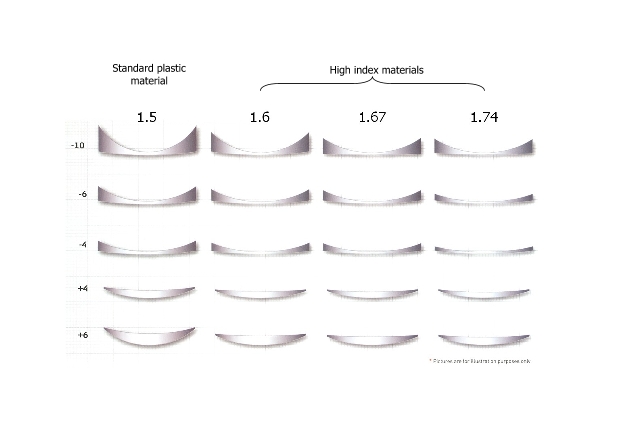As technology advances, so do spectacle lenses. In the past spectacles lenses were made of glass where as today they are made of high tech plastic materials.
When choosing lenses there are three decisions that have to be made:
- What type of lens… Single vision, Bifocal, Multifocal, Office or Digital.
- What type of lens material… Standard plastic or Hi-Index.
- What lens coating… Anti-reflecting, Photochromatic, Sunglass, Blue blocking anti-reflecting
The best combination of options is based on your personal preference, lifestyle, prescription and work requirements.
1) What Type of Lens
Single Vision
The lens power is the same all over the lens and assists the wearer to focus either at distance , near, intermediate or all of these areas.
Bifocal Lenses
These are older style lenses occasionally used. There are two lens powers on the lens, the upper portion helps the wearer focus at distance and the lower at near. There is a line visible that separates the lens powers.
Multifocal Lenses
These are lenses designed to focus at distance, intermediate and near. The upper part of the lens is for distance, the middle for intermediate and the lower for near. There are no lines visible on the lenses and the power of the lens changes as you move up and down the lens..Read More… OSA Accolade Freedom
Office Lenses
For people that work in an office environment who require near to intermediate vision. They offer a large field of vision at close and intermediate distances, allowing a person to adopt an unimpaired view of the screen with a natural posture and sitting position….Read More… Zeiss Offfice Lenses
Digital Lenses
These lenses are similar to multifocal lenses, ie they have a distance , intermediate and near power. They are prescribed mainly to assist younger persons focusing on digital devices and persons starting to experience age related near vision loss..Read More… Zeiss Digital Lenses
2) What Type of Lens Material
Standard plastic material is appropriate for low power prescriptions.
Hi Index materials are plastic materials of higher density designed to reduce the thickness of the lens. Hi index lenses look much better when a prescription is very high.
There are three distinct categories of high index material…1.6, 1.67 and 1.74.
The diagram below illustrates the thickness reductions of different hi-index materials and prescriptions.

3) What Type of Lens Coating
Anti-Reflecting
A coating applied to the lens surface to reduce reflections. It helps reduce eyestrain with computer use, enhances night vision and allows you to see clearer through the lens by increasing light transmission through the lens to 99%.
Photochromatic
A coating on spectacles lenses that allows lenses to darken on direct exposure to sunlight and return to clear when indoors. This coating allows your normal spectacles to become sunglasses in direct sunlight.
Sunglass
A lens coating that reduces direct and reflected sunlight from entering the eyes and also blocks ultaviolet light.
Sunglass coatings can be either a tint or polarised coating. A tint coating will reduced direct sunlight and some reflected sunlight. Whilst a polarised coating will reduced direct and reflected sunlight..Read More… Essilor Experio Polarised Lenses
Blue Blocking Anti-Reflecting
A lens coating that blocks high energy blue light emitted by electronic devices. Blue light can adversely impact your circadian rhythm ( the body’s natural sleep & wake cycle ).